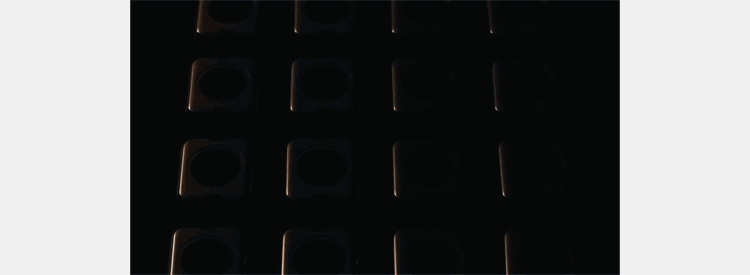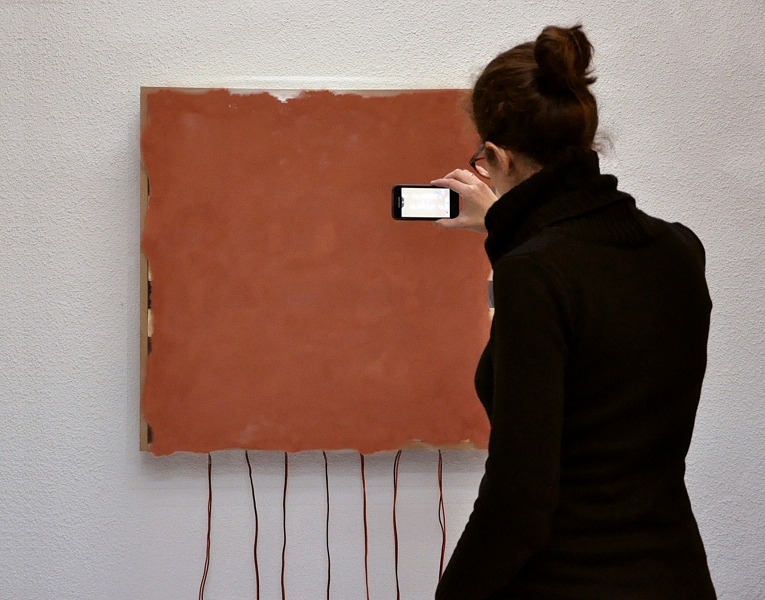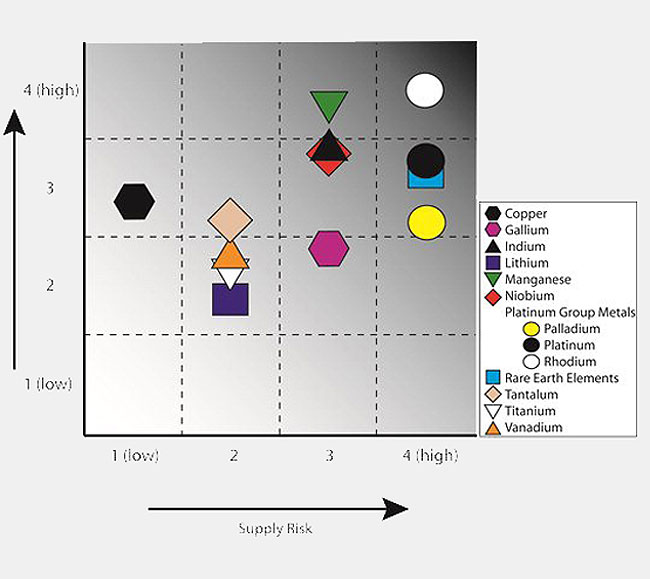— The Alchemic Digital, The Planetary Elemental

As expressed in panmetallism, metal is coextensive to the whole of matter, and the whole of matter to metallurgy. Even the waters, the grasses and varieties of wood, the animals, are populated by salts or mineral elements. Not everything is metal, but metal is everywhere. Metal is the conductor of all matter. —Deleuze and Guattari1Gilles Deleuze and Felix Guattari, A Thousand Plateaus (London: Continuum, 2004), 454.
If not magical, it’s at least alchemical. The visual rhetoric of corporate computation is no longer merely a world of wizardry, of all sorts of technological operations pertaining to software as an immaterial regime of things conjured from nowhere. It’s not merely the creative design magicians pulling the proverbial bunny out of the hat, which, as Jacques Lacan reminded us, is there only if you put it there in the first place (as every designer should know). Rather, its visual rhetoric has become about material production as the showcase of digital luxury.2Jacques Lacan, The Seminar of Jacques Lacan, Book II: The Ego in Freud’s Theory and in the Techniques of Psychoanalysis, 1954–1955, ed. Jacques-Alain Miller, trans. Sylvana Tomiselli (Cambridge: Cambridge University Press, 1988), 61.
The four elements seem to have been reduced to three. Echoing Paracelsus’s sixteenth-century suggestion that there are three metallic principles, the new alchemies of corporate digital culture suggest a sort of a chemical mixture. Gold, aluminum, and stainless steel are the highly managed, standardized elements of Apple Watch marketing material. Narrated by a low, calm male voice that to some ears invites parody, the marketing is made to look as highly refined as the product. Liquids turn to solids, and when nature fails to satisfy, engineers custom-design alloys specifically for luxury smart timekeeping. The demand for personalized digital objects is met with standardized materials. Eighteen-carat solid gold becomes a reference point for gadgets. Metallurgical hardening processes confirm customized metal’s necessary hardness. Ultrasonic scanners guarantee its smoothness.
These technological processes measure materials, filter impurities, and commence a process of the pore-free already before solidification. It’s a more metallic version of the trope of “machines making machines” that features in science fiction and also in current online documents showing how, for example, Arduino boards are factory produced.3Arduino Production Factory Tour, YouTube, March 20, 2014 → At the other end of technological culture lies obsolescence; in a way, Tacita Dean’s 2006 film Kodak speaks to the factory culture behind the materiality of images by looking at the production of 16-millimeter film stock, creating scenes of industrial technological visual culture where automated things move whether we are watching or not.

With gold, aluminum, and steel, the metallic gives out a light, a shine that is the visual of the digital that persists for decades despite the reality of digital culture turning to darker affective moods of anxiety, betrayal, and secrecy. This radiant shine of visual culture in its corporate optimism, of even such smaller screens as the watch, is underpinned by the material, the elemental: the four pre-Socratic elements—and the later medieval alchemical variations that included sulfur and mercury—find their way into a politically significant vocabulary concerning the subtle interplay of opacity and metallic digital culture. Their mythological connotations are apt to tease out. While sulfur is the smelly trace of the devil and hell, mercury is the messenger of the gods, but also the original trickster, as the root element for Hermes—who is nowadays more the luxury brand than the symbol of hermeneutics.4Thank you to Ryan Bishop for reminding me about the mythological connotations of the medieval alchemic elements.
Indeed, considering luxury culture, “Shine could be the paradoxically material base of an optical economy typically (mis)understood as being purely cognitive or immaterial.”5Tom Holert, Julieta Aranda, Brian Kuan Wood, and Anton Vidokle, “Editorial – ‘Politics of Shine,’” e-flux journal 61 (January 2015) → The alchemy of such visual surfaces, as well as their material processes, seem to have fulfilled Zosimus’s fifth-century dream of “The Divine Art of Making Gold and Money” that rings true as to the place of technology in contemporary culture.6Paul-Jacques R. Malouin, “Alchemy,” The Encyclopedia of Diderot & d‘Alembert Collaborative Translation Project, trans. Lauren Yoder (Ann Arbor: Michigan Publishing, University of Michigan Library, 2003) →. “Alchimie,” Encyclopédie ou Dictionnaire raisonné des sciences, des arts et des métiers, vol. 1, Paris, 1751. For an alternative take on alchemy and digital practices, see Denisa Kera, “Conflict-Free Minerals and Open Source Hardware: Homunculus or Minerals Baby?” Talk at the transmediale festival, Berlin, February 1, 2015. The whole panel “The Media of the Earth” can be found online → Art projects also engage with this premise—for example, Abelardo Gil Fournier’s Mineral Vision installation (2015): a copper slab whose silent façade opens up through augmented reality vision, revealing the quasi-mythological world of hidden messages; the digital opens up the material that becomes itself readable.7See → It’s the new, technological version of Roger Caillois’s The Writing of Stones.8Roger Caillois, The Writing of Stones, trans. Barbara Bray (Charlottesville: University Press of Virginia, 1985).

Metals such as gold, of course, are not merely found in mines. Though gold may no longer function as a global financial standard, it maintains its luxury status. The circulation of materials such as gold, aluminum, and steel as modern materials par excellence defines a relation to both the technological and the organic; both waste products can be mined for a further level of geological reuse. The e-waste practices of dealing with discarded electronics find their organic counterpart in the scanning of excrement and sludge for precious metals. Studies have shown that one kilogram of sludge contains about 0.4 milligrams of gold, twenty-eight milligrams of silver, 638 milligrams of copper, and forty-nine milligrams of vanadium.9Hannah Devlin, “Gold in faeces ‘is worth millions and could save the environment,’” The Guardian, March 23, 2015 → Planetary depletion combined with massive market demand necessitate that the alchemical mindset extend to the basic chemistry of filtering—water from waste, metals from excrement. The material ecology of technology itself is heavy with ores and minerals.
This apparent magic gets integrated into an operational body of knowledge about the elements as the base of modern technological culture. This rhetorical alchemy comes out in a mythologizing of the corporate and financial worlds of technology. Magic, alchemy, and impossible creatures have never really disappeared. Secret knowledge is still held, but more often by way of legal means such as intellectual property and other measures related to finance, or just state security. Magic is thus conjured in a new, metaphorical disguise found both in marketing and in business parlance.
Unicorns are one such dream animal that reappear as part of the finance venture jargon. The mythological creature is now a reference to the “billion-dollar club”—software start-ups valued above one billion dollars. Now venture capitalists are aiming even higher, with companies reaching the ten-billion-dollar mark—the decacorn.10Erin Griffth and Dan Primack, “The Age of Unicorns,” Fortune, January 22, 2015 →. Thanks to Geraldine Juarez for the heads-up on this theme. On money’s mythic contexts in relation to figures such as the Trickster, the Devil, and the Fool, see Angus Cameron, “Money’s unholy trinity: Devil, trickster, fool,” Culture and Organization, 2015.
Or take the material mythology of some of the corporations of the digital, such as their penchant for showcasing the factories that produce the elements that go into their products. Both the finance world’s logic and the corporate networks of technology speak to the Enlightenment definition of magic as “The occult art or science which teaches how to do things which are beyond human powers.”11“Magic,” The Encyclopedia of Diderot & d'Alembert Collaborative Translation Project, trans. Steve Harris (Ann Arbor: Michigan Publishing, University of Michigan Library, 2010) →. “Magie,” Encyclopédie ou Dictionnaire raisonné des sciences, des arts et des métiers, vol. 9, Paris, 1765. Indeed, the nonhuman is found in finance as well as in the corporations that enable transactions of a quasi-magical kind. This “beyond human powers” refers merely to the massive supply chain operations that govern the emergence of technological media objects. Such transformations are the less polished surface of the visual rhetoric of alchemy, even as the two are intimately linked. In Rare Earthenware (2014) by Unknown Fields, this transformation is tracked in terms of chains of production and the redesign of something that is symbolically luxurious but made of waste: ceramics in the style of Ming vases, but made from the toxic waste residue of smartphone, laptop, and car batteries.12 See →

Unicorns, alchemists, the wizardry of creative corporations: the lineage of magic and technology takes a rhetorically magical turn in the digital age. “Sourcery” of the source code fascinates when it comes to the computational, but the other imaginary of contemporary alchemy is just as important.13Wendy Hui Kyong Chun, “On ‘Sourcery,’ or, Code as Fetish,” Configurations, vol. 16, no. 3 (Fall 2008): 299–324. The trickery of design is underpinned by the work of material sciences and engineering: the work of labor, materials, and the wider logistical infrastructures in which materials are mutated.14See Benedict Singleton, “The Maximum Jailbreak,” e-flux journal 46 (June 2013) → This transmutation works not by magic but by chemistry and geographically dispersed labor conditions in contemporary capitalism that produce the effect of creative magic, although if one is accurate enough it happens mostly in the various alternative zones that guarantee legal frameworks for material magic. The planetary computation that enables smaller-scale computation to take place is present already at this stage; logistics software ensures the smooth passage, storage, and usability of materials matched to labor. If the history of (natural) magic builds upon self-moving automata such as “Archimedes’ glass sphere, Architras’ flying wooden dove, the Emperor Leo’s singing golden birds, Boetius’ singing and flying bronze birds, hissing bronze serpents,” the global automata of logistics is how to move other things—from hissing and flying animals to singing humans, from sneakers to iPads.15 “Magic,” The Encyclopedia of Diderot & d'Alembert Collaborative Translation Project. Movement is what is visualized and organized through the software. And yet, as Ned Rossiter argues in his proposal for a media theory of logistics, “for the most part the enterprise resource planning (ERP) software remains a black box for those not directly using these systems as a matter of routine in their daily work across a range of industries, which include but are not limited to logistical industries.”16Ned Rossiter, “Materialities of Software: Logistics, Labour, Infrastucture” →
Watches that measure time—and the various biorhythms and other data captured—are then, besides personal items, also connected to the planetary periodicity, analysis, and computation of materials, which are of course not merely limited to gold, aluminum, and steel. This is a matter of the periodic table, since circa 1869, being operationalized as the reference point for the material economy. As one contemporary commentator in 1891 suggested, addressing the transformation of alchemy to chemistry, the technological analysis of the elemental becomes a way to understand the neo-Pythagorean order of nature.17 R. C. Kedzie, “Alchemy,” Science, XVIII, no. 447 (August 28, 1891): 116. Planetary computation is one media that is archeologically conditioned by the rhythm of chemical elements, a periodicity that shows an underlining potentiality of nature.18See Manuel DeLanda, Deleuze: History and Science (New York: Atropos, 2010), 86–87.
And there are also the technological apparatuses that have allowed us to understand elemental qualities and relations. The spectroscope, visual technology itself, “enables us to peer into the very heart of nature.”19 Kedzie, “Alchemy.” The spectroscopic look into chemical composition can be said to be as important to the emergence of new media cultures as to the usual story of cinema cultures born around the same time. This actually provides a look into chemico-technical—and hence also digital—media by way of the parallels drawn: like the telescope opened up the world of stars, “the spectroscope will yet reveal swarms of meta-metals in the chemical system.”20 Ibid. Speculation ensues, treating this as an exciting world of discovery, as alchemy once was, here described in 1891:
Does the splitting up of the rare metals justify the assumption that the metals most fixed in character, and which show no tendency to split into meta-metals, such as gold and platinum, are compound in constitution and may be compounded out of baser materials? Crookes’s suggestion that what comes to us as copper has been shunted on to the wrong track in its passage from aboriginal elemental matter to make gold, holds out small hope to metallic transmutation.21Ibid.
It’s less the systematic mineralogy collections that define the visual culture of the Earth that is on display, and more the chemistry of what is pulled out and combined according to chemical possibilities. The visual culture of minerals was already earlier recognized in terms of optics—for example, the use of fluorite in camera lenses, microscopes, and telescopes. Late-nineteenth-century research into the ultraviolet spectrum was based on lens technologies that benefited from this realization. One begets the other. Metals, minerals, and the Earth form one ground of the technological, from optics and visuality to the digital today. But further uses of rare earth minerals are less about optics than about the chemistry of how they can be catalyzed. This includes such fine details as the planetary dimensions of a single computer chip, with the dozens of mineral elements it takes to manufacture one—a body of planetary knowledge condensed into a technological artifact. This notion of “planetary” has a molecular constitution, where the most local element is already potentially a planetary mixture in its chemical composition.22Benjamin Bratton, “Chemistry and Urbanism,” Fulcrum 84 (2014).
We move from panpsychism to the panmetallism, the geopolitics of metals and minerals: the luxury smartwatch digital culture of the elemental. It is alchemy in its visual rhetorics, but it is the chemistry of the periodic table in the potentials of its molecular combinations.
×


